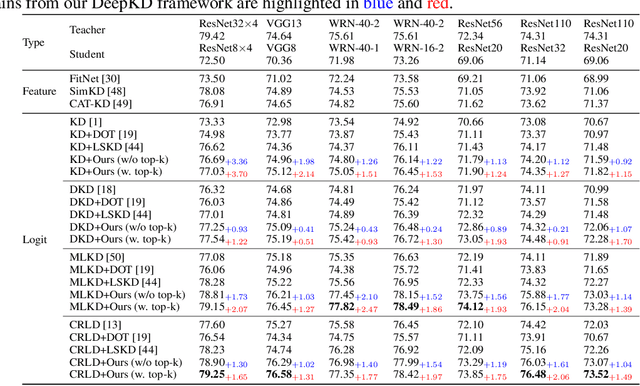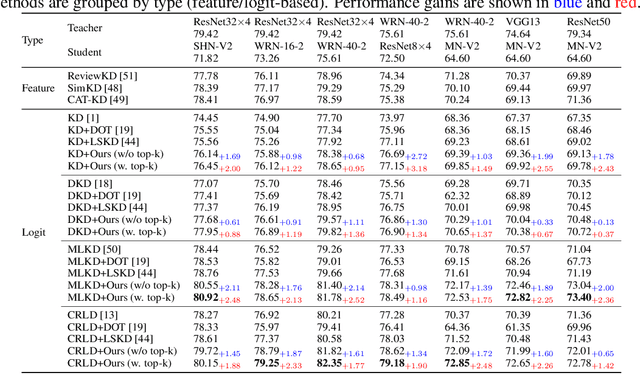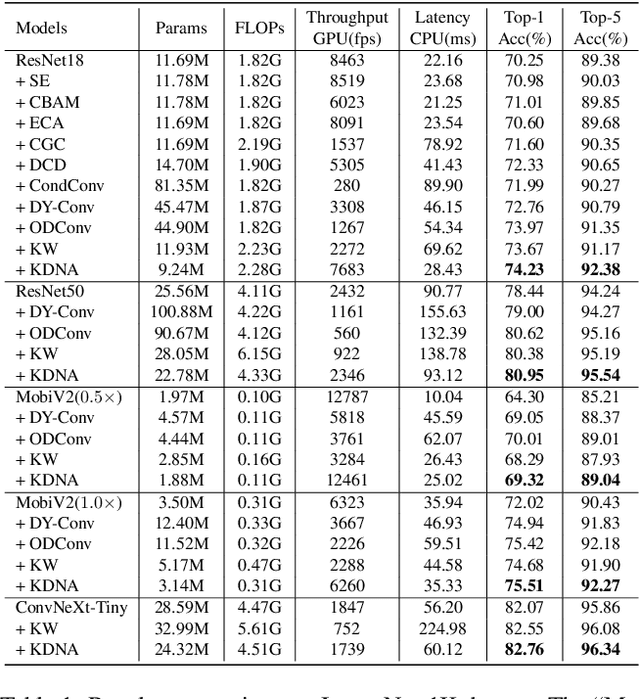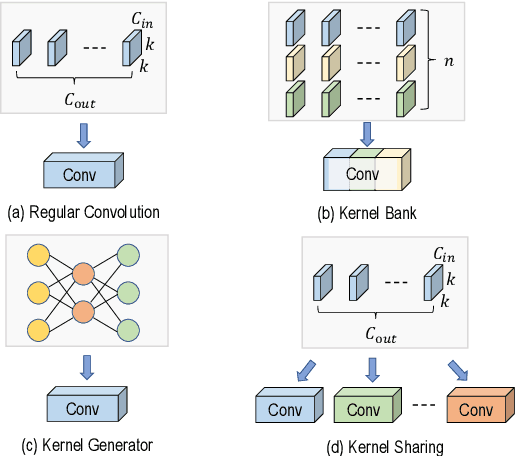Haiduo Huang
DeepKD: A Deeply Decoupled and Denoised Knowledge Distillation Trainer
May 21, 2025



Abstract:Recent advances in knowledge distillation have emphasized the importance of decoupling different knowledge components. While existing methods utilize momentum mechanisms to separate task-oriented and distillation gradients, they overlook the inherent conflict between target-class and non-target-class knowledge flows. Furthermore, low-confidence dark knowledge in non-target classes introduces noisy signals that hinder effective knowledge transfer. To address these limitations, we propose DeepKD, a novel training framework that integrates dual-level decoupling with adaptive denoising. First, through theoretical analysis of gradient signal-to-noise ratio (GSNR) characteristics in task-oriented and non-task-oriented knowledge distillation, we design independent momentum updaters for each component to prevent mutual interference. We observe that the optimal momentum coefficients for task-oriented gradient (TOG), target-class gradient (TCG), and non-target-class gradient (NCG) should be positively related to their GSNR. Second, we introduce a dynamic top-k mask (DTM) mechanism that gradually increases K from a small initial value to incorporate more non-target classes as training progresses, following curriculum learning principles. The DTM jointly filters low-confidence logits from both teacher and student models, effectively purifying dark knowledge during early training. Extensive experiments on CIFAR-100, ImageNet, and MS-COCO demonstrate DeepKD's effectiveness. Our code is available at https://github.com/haiduo/DeepKD.
KernelDNA: Dynamic Kernel Sharing via Decoupled Naive Adapters
Mar 30, 2025



Abstract:Dynamic convolution enhances model capacity by adaptively combining multiple kernels, yet faces critical trade-offs: prior works either (1) incur significant parameter overhead by scaling kernel numbers linearly, (2) compromise inference speed through complex kernel interactions, or (3) struggle to jointly optimize dynamic attention and static kernels. We also observe that pre-trained Convolutional Neural Networks (CNNs) exhibit inter-layer redundancy akin to that in Large Language Models (LLMs). Specifically, dense convolutional layers can be efficiently replaced by derived ``child" layers generated from a shared ``parent" convolutional kernel through an adapter. To address these limitations and implement the weight-sharing mechanism, we propose a lightweight convolution kernel plug-in, named KernelDNA. It decouples kernel adaptation into input-dependent dynamic routing and pre-trained static modulation, ensuring both parameter efficiency and hardware-friendly inference. Unlike existing dynamic convolutions that expand parameters via multi-kernel ensembles, our method leverages cross-layer weight sharing and adapter-based modulation, enabling dynamic kernel specialization without altering the standard convolution structure. This design preserves the native computational efficiency of standard convolutions while enhancing representation power through input-adaptive kernel adjustments. Experiments on image classification and dense prediction tasks demonstrate that KernelDNA achieves state-of-the-art accuracy-efficiency balance among dynamic convolution variants. Our codes are available at https://github.com/haiduo/KernelDNA.
Gumiho: A Hybrid Architecture to Prioritize Early Tokens in Speculative Decoding
Mar 13, 2025Abstract:Speculative decoding (SPD) aims to accelerate the auto-regressive token generation process of a target Large Language Model (LLM). Some approaches employ a draft model with multiple heads to predict a sequence of future tokens, where each head handles a token in the sequence. The target LLM verifies the predicted sequence and accepts aligned tokens, enabling efficient multi-token generation. However, existing methods assume that all tokens within a sequence are equally important, employing identical head structures and relying on a single-generation paradigm, either serial or parallel. To this end, we theoretically demonstrate that initial tokens in the draft sequence are more important than later ones. Building on this insight, we propose Gumiho, a hybrid model combining serial and parallel heads. Specifically, given the critical importance of early tokens, we employ a sophisticated Transformer architecture for the early draft heads in a serial configuration to improve accuracy. For later tokens, we utilize multiple lightweight MLP heads operating in parallel to enhance efficiency. By allocating more advanced model structures and longer running times to the early heads, Gumiho achieves improved overall performance. The experimental results demonstrate that our method outperforms existing approaches, fully validating its effectiveness.
Partial Convolution Meets Visual Attention
Mar 05, 2025Abstract:Designing an efficient and effective neural network has remained a prominent topic in computer vision research. Depthwise onvolution (DWConv) is widely used in efficient CNNs or ViTs, but it needs frequent memory access during inference, which leads to low throughput. FasterNet attempts to introduce partial convolution (PConv) as an alternative to DWConv but compromises the accuracy due to underutilized channels. To remedy this shortcoming and consider the redundancy between feature map channels, we introduce a novel Partial visual ATtention mechanism (PAT) that can efficiently combine PConv with visual attention. Our exploration indicates that the partial attention mechanism can completely replace the full attention mechanism and reduce model parameters and FLOPs. Our PAT can derive three types of blocks: Partial Channel-Attention block (PAT_ch), Partial Spatial-Attention block (PAT_sp) and Partial Self-Attention block (PAT_sf). First, PAT_ch integrates the enhanced Gaussian channel attention mechanism to infuse global distribution information into the untouched channels of PConv. Second, we introduce the spatial-wise attention to the MLP layer to further improve model accuracy. Finally, we replace PAT_ch in the last stage with the self-attention mechanism to extend the global receptive field. Building upon PAT, we propose a novel hybrid network family, named PATNet, which achieves superior top-1 accuracy and inference speed compared to FasterNet on ImageNet-1K classification and excel in both detection and segmentation on the COCO dataset. Particularly, our PATNet-T2 achieves 1.3% higher accuracy than FasterNet-T2, while exhibiting 25% higher GPU throughput and 24% lower CPU latency.
Jakiro: Boosting Speculative Decoding with Decoupled Multi-Head via MoE
Feb 10, 2025Abstract:Speculative decoding (SD) accelerates large language model inference by using a smaller draft model to predict multiple tokens, which are then verified in parallel by the larger target model. However, the limited capacity of the draft model often necessitates tree-based sampling to improve prediction accuracy, where multiple candidates are generated at each step. We identify a key limitation in this approach: the candidates at the same step are derived from the same representation, limiting diversity and reducing overall effectiveness. To address this, we propose Jakiro, leveraging Mixture of Experts (MoE), where independent experts generate diverse predictions, effectively decoupling correlations among candidates. Furthermore, we introduce a hybrid inference strategy, combining autoregressive decoding for initial tokens with parallel decoding for subsequent stages, and enhance the latter with contrastive mechanism in features to improve accuracy. Our method significantly boosts prediction accuracy and achieves higher inference speedups. Extensive experiments across diverse models validate the effectiveness and robustness of our approach, establishing a new SOTA in speculative decoding. Our codes are available at https://github.com/haiduo/Jakiro.
Partial Channel Network: Compute Fewer, Perform Better
Feb 03, 2025Abstract:Designing a module or mechanism that enables a network to maintain low parameters and FLOPs without sacrificing accuracy and throughput remains a challenge. To address this challenge and exploit the redundancy within feature map channels, we propose a new solution: partial channel mechanism (PCM). Specifically, through the split operation, the feature map channels are divided into different parts, with each part corresponding to different operations, such as convolution, attention, pooling, and identity mapping. Based on this assumption, we introduce a novel partial attention convolution (PATConv) that can efficiently combine convolution with visual attention. Our exploration indicates that the PATConv can completely replace both the regular convolution and the regular visual attention while reducing model parameters and FLOPs. Moreover, PATConv can derive three new types of blocks: Partial Channel-Attention block (PAT_ch), Partial Spatial-Attention block (PAT_sp), and Partial Self-Attention block (PAT_sf). In addition, we propose a novel dynamic partial convolution (DPConv) that can adaptively learn the proportion of split channels in different layers to achieve better trade-offs. Building on PATConv and DPConv, we propose a new hybrid network family, named PartialNet, which achieves superior top-1 accuracy and inference speed compared to some SOTA models on ImageNet-1K classification and excels in both detection and segmentation on the COCO dataset. Our code is available at https://github.com/haiduo/PartialNet.
Nearly Lossless Adaptive Bit Switching
Feb 03, 2025



Abstract:Model quantization is widely applied for compressing and accelerating deep neural networks (DNNs). However, conventional Quantization-Aware Training (QAT) focuses on training DNNs with uniform bit-width. The bit-width settings vary across different hardware and transmission demands, which induces considerable training and storage costs. Hence, the scheme of one-shot joint training multiple precisions is proposed to address this issue. Previous works either store a larger FP32 model to switch between different precision models for higher accuracy or store a smaller INT8 model but compromise accuracy due to using shared quantization parameters. In this paper, we introduce the Double Rounding quantization method, which fully utilizes the quantized representation range to accomplish nearly lossless bit-switching while reducing storage by using the highest integer precision instead of full precision. Furthermore, we observe a competitive interference among different precisions during one-shot joint training, primarily due to inconsistent gradients of quantization scales during backward propagation. To tackle this problem, we propose an Adaptive Learning Rate Scaling (ALRS) technique that dynamically adapts learning rates for various precisions to optimize the training process. Additionally, we extend our Double Rounding to one-shot mixed precision training and develop a Hessian-Aware Stochastic Bit-switching (HASB) strategy. Experimental results on the ImageNet-1K classification demonstrate that our methods have enough advantages to state-of-the-art one-shot joint QAT in both multi-precision and mixed-precision. We also validate the feasibility of our method on detection and segmentation tasks, as well as on LLMs task. Our codes are available at https://github.com/haiduo/Double-Rounding.
FTP: A Fine-grained Token-wise Pruner for Large Language Models via Token Routing
Dec 16, 2024Abstract:Recently, large language models (LLMs) have demonstrated superior performance across various tasks by adhering to scaling laws, which significantly increase model size. However, the huge computation overhead during inference hinders the deployment in industrial applications. Many works leverage traditional compression approaches to boost model inference, but these always introduce additional training costs to restore the performance and the pruning results typically show noticeable performance drops compared to the original model when aiming for a specific level of acceleration. To address these issues, we propose a fine-grained token-wise pruning approach for the LLMs, which presents a learnable router to adaptively identify the less important tokens and skip them across model blocks to reduce computational cost during inference. To construct the router efficiently, we present a search-based sparsity scheduler for pruning sparsity allocation, a trainable router combined with our proposed four low-dimensional factors as input and three proposed losses. We conduct extensive experiments across different benchmarks on different LLMs to demonstrate the superiority of our method. Our approach achieves state-of-the-art (SOTA) pruning results, surpassing other existing pruning methods. For instance, our method outperforms BlockPruner and ShortGPT by approximately 10 points on both LLaMA2-7B and Qwen1.5-7B in accuracy retention at comparable token sparsity levels.
 Add to Chrome
Add to Chrome Add to Firefox
Add to Firefox Add to Edge
Add to Edge